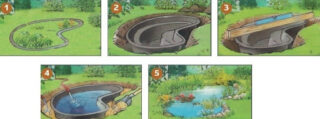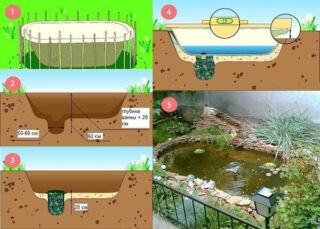The construction of a pond on the site is a design solution that is relevant for a summer residence and a country cottage. Information about the nuances of building your own reservoir will allow you to select the necessary materials and calculate the budget. The presented ideas for improving the pond will help to decorate the elements of the yard in a single style.
- Pond device approval
- Requirements for building a pond
- Types of ponds and their differences
- Choosing the location and size of the reservoir
- Pond construction technology in the country
- Finished form
- Use of film
- Use of scrap materials
- Decorating a country pond
- Features of preparing a summer cottage for wintering
Pond device approval

In the legislation of the Russian Federation, GOST 19179-73 is established, on the basis of which a pond is a reservoir built on a private territory. If it is dug for water storage and / or economic use, there is no need to issue a permit.
Requirements for building a pond
The legal difference between a pond in a dacha and other types of water bodies is the ownership of the land where it was built. If the site is owned by the municipality, an appeal to the authorities will be required.
Legal features of building a pond with your own hands:
- There are no restrictions on the creation of artificial reservoirs.
- You do not need to obtain a permit if the land is registered as ownership.
- A construction permit is required when it is planned to connect a pond with a federal water body.
Arrangement of dams or location in the channel of a watercourse is regarded as a reservoir. However, there is no single normative act governing construction. All established norms are contained in different laws, which creates legal conflicts.
Types of ponds and their differences

Before creating a pond with your own hands, it is recommended to choose a suitable shape and size. Study the technology and think over the decoration of the reservoir. Designers note that a small lake is relevant for a vast territory, but in any case, it is necessary to create a single ensemble.
Depending on the assigned functions, there are four types of artificial reservoirs:
- Small form - designed to decorate the garden area, playing the role of an element of landscape design. Active rest is not expected near such a reservoir.
- Pond for breeding fish - the size depends on the capabilities of the owner and the parameters of the territory. It is allowed to build a small backwater, for example, with beautiful cold water trout. This idea will require the installation of a filtration system and oxygen enrichment equipment.
- A decorative reservoir is a medium-depth reservoir equipped with a curb, bridge and lighting.
- Swimming pond is a type of pool.
The purpose of the reservoir determines the location, size and shape. When planning to make a water reservoir on the site, decide on the style. The normal version provides for a stable design of various modifications. The following styles are used in landscape design - classic, modern, high tech and minimalism. The pond, decorated in a landscape style, features a broken coastline. The only condition is natural appearance.
The style determines the relief of the suburban area. The flat surface allows you to equip a pond of any configuration. Sharp changes and the presence of a slope suggest the construction of cascading waterfalls, bridges, and wooden flooring.
Choosing the location and size of the reservoir

There are no uniform rules for choosing the location or size of the pond. Each owner decides for himself what shape to give the tank: a circle, a square or an asymmetry. The main task of the improvement is the formation of a single style on the site.
For example, the cascade type involves finding a suitable location. Consider the properties of the soil and terrain. If the area is hilly, a stream with rapids will fit perfectly into the landscape. For a flat surface, create a homemade pond.
The presence of trees with a strong root system near the reservoir can cause the slopes of the home lake to collapse. In addition, leaves and debris will clog the tank. Cleaning the pond will become a daily concern.
For decoration in a modern style, an open, sunny space is relevant. The rays contribute to the heating of water, the development of flora and fauna of the reservoir. Position the pond so that the smaller part of it is in the shade.
Pond construction technology in the country
For the construction of a pond in the country with their own hands, three methods have been developed - a ready-made form, the use of film or scrap materials. A step-by-step algorithm of work will help to simplify the process of arranging a reservoir in the garden.
Finished form

Before making a pond with your own hands, find a suitable place and a manufacturer of structures. Most manufacturers supply impact-resistant plastic molds to the market. The products are durable and easy to clean.
Construction of an artificial reservoir on a site with a house:
- Find a place on the site and place the finished shape on the ground. Circle the structure - you need to dig a hole according to the lines. The dimensions of the pit are set more than the tank by 10 cm.
- After placing the mold, fill the container with 1/3 of water. Pour soil mixed with sand into the formed voids.
- Add soil gradually and fill the form to the brim.
- Cover the contour with a wild stone, plastic, or plant moisture-loving plants. Do the decorating step after 100% shrinkage of the structure.
Concrete bowls are relevant for bathing reservoirs. A solid foundation is also used for northern latitudes with sharp temperature changes.
Use of film

You can ennoble a garden or a personal plot with your own hands using a film. To avoid mistakes, follow the step-by-step algorithm of work and familiarize yourself with the intricacies of the process.
Buy waterproofing material with a margin of size, since when installing a pond, it will take 20-30 cm to fix the edges.
To erect a landscape element, you will need tools:
- nylon cord or rope;
- polyvinyl chloride film;
- bricks;
- sand;
- stones;
- shovel.
Spread the film out in a sunny place 3-4 hours before starting work. Under the influence of rays, the material heats up and becomes more elastic.
Instructions:
- Use a fishing line to mark the outline of the reservoir. The pit should be dug according to the dimensions indicated in the project. At the end of the work, debris is cleaned out from the bottom, tree roots are uprooted and large objects are removed. This will prevent damage to the material.
- Pour sand or fine crushed stone at the bottom of the pit - the layer thickness is from 10 cm.
- Installation of a waterproofing film is carried out over the created "pillow". If the width of the material is not enough, connect the pieces with a solder.
- It is recommended to make a pit in several levels, even if there is no stream or cascade in the project. The formed steps will serve as a platform for planting plants. Due to the lack of soil, the flowers are placed in pots.
- Around the perimeter of the reservoir, dig a ditch 15 cm deep. It is necessary to secure the edges of the film. Cover the moat with gravel. From above, the material allowance should be at least 0.5 meters - this will allow you to fix the structure with high quality. Fill the finished reservoir with water.
- Overlay the contour with large pebbles or plastic.
Arranging a pond with your own hands takes no more than one day. Adhere to technology and guidelines to create a reliable design. At the final stage, plant the plants.
Use of scrap materials

The manufacture of a concrete base, as well as the purchase of a finished form or film, does not always correspond to the budget of the dacha owner. To create an artificial reservoir on the site, it is enough to use unnecessary household items. As a rule, this does not require digging a foundation pit and purchasing construction tools.
In organizing a pond on a site with your own hands, you can use improvised materials:
- An old bathtub made of cast iron or acrylic - you don't need to dig a hole for the arrangement, it is enough to create a small depression. Fill the place for draining the water with small pebbles or expanded clay. Cover the bottom of the tank with varnish or water-repellent paint.
- The installation of a copper basin also does not require a foundation pit. It is allowed to use the container as a temporary pond or a stationary element of landscape design.
- Covers can become a decorative part of the garden if the structure is properly formed. Cut the product in half and place it in a prepared hole. Treat the surface with plastic foil.
- Galvanized buckets, plastic pots and barrels are all suitable for creating a small pond. Use polymer materials as waterproofing. In such tanks, aquatic plants are grown.
Minimal costs, coupled with a creative approach, allow you to create an original reservoir. Decorating a plot with your own hands is a separate art form. With the right approach, the pond will become the final element of the landscape.
Decorating a country pond

After completing the construction of the pond, start decorating. Design elements can be purchased at the store or used materials at hand, including small trees or bonsai.
Ideas for an artificial reservoir:
- live fish and aquatic plants;
- wooden mill;
- arrangement of a bridge, fountain or cascade stream;
- backlit equipment;
- installation of a bench and other furniture for rest;
- refining with stone or colored gravel;
- installation of a forged fence.
The decor is the final stage, forming a single ensemble on the site. During the arrangement, experts recommend adhering to the following rules:
- Choose stones of about the same size. Layering of different elements creates chaos and is visually repulsive.
- Take care of the safety of your household - do not use sharp and fragile objects. The structure must be reliable and sturdy.
- Do not dig a pit with a steep wall, since such a pit is difficult to decorate.
- Container gardening is easy to maintain.
Design fantasies are inexhaustible. The choice of this or that decoration element depends on the taste of the owner of the cottage. Regardless of the budget, the reservoir on the site should not get out of the general style of the landscape.
Features of preparing a summer cottage for wintering
In the autumn, the foliage falls into the pond and sinks to the bottom. The dead parts of the flora, together with microorganisms, form silt, which leads to the pollution of the reservoir. If there are many trees nearby before wintering, you need to prepare the water for frost:
- During leaf fall, stretch a fine mesh over the surface.
- Do not cut off aquatic and coastal plants - representatives of the fauna hide in them for the winter.
- Leave the stems that rise above the water, because oxygen enters the pond through them, preventing deep freezing of the water.
- Remove service equipment - clean, lubricate parts with machine oil and store in a barn.
If the pond freezes, do not try to break the ice - this scares the fish and other aquatic life.









